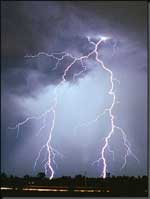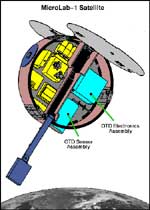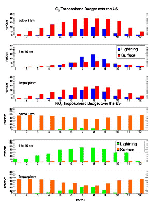|
SURPRISE! LIGHTNING HAS BIG EFFECT ON ATMOSPHERIC CHEMISTRY
 |
|
 |
|
Image 1
|
| |
Scientists were surprised to learn summer lightning
over the U.S. significantly increases regional ozone and
other gases that affect air chemistry 3 to 8 miles above
Earth's surface.The amounts of ozone and nitrogen oxides
created by lightning surpass those generated by human
activities in that level of the atmosphere.
Typically over the U.S., fossil fuel burning is the main
cause of nitrogen oxides (NOx), which lead to the formation
of ozone near the Earth's surface. However, above the
Earth's surface in the free troposphere (3-8 miles high),
during the summer months, lightning activity increases NOx
by as much as 90 percent and ozone by more than 30 percent.
 |
|
 |
|
Image 2
|
| |
Renyi Zhang of Texas A&M University, lead author of a paper
that recently appeared in the Proceedings of the National
Academy of Sciences, suggests lightning has distinct impacts
on air chemistry over the U.S. Human activities dominate the
creation of these gases near the Earth's surface, but
lightning plays a bigger role in the free troposphere.
Depending on where ozone resides, it can protect or harm
life on Earth. Most ozone resides in the stratosphere (a
layer of atmosphere between 8 and 25 miles high), where it
shields life on Earth from the sun's harmful ultraviolet
radiation. At the surface, ozone is a harmful pollutant that
causes damage to lung tissue and plants. In the troposphere
(surface to 8 miles high) ozone also is a radiatively active
gas that affects climate.
About 77 million lightning bolts annually strike the U.S.
Measurements before and after lightning strikes have
confirmed the generation of nitrogen oxides in the
atmosphere.
 |
|
 |
|
Image 3
|
| |
"Ironically, over the United States lightning accounts for
only about 5 percent of the total U.S. nitrogen oxide annual
emissions and about 14 percent of the total emissions in
July," said Zhang. Although the largest source of NOx over
the U.S. is fossil fuel burning, lightning still plays a
dominant role in influencing the regional air chemistry.
The explanation is NOx from fossil fuel burning is released
close to the Earth's surface and is consumed rapidly by
chemical reactions before being transported upward.
Lightning, however, directly releases NOx throughout the
entire troposphere. The lightening source over North America
for NOx is sufficiently large, so that it has implications
on free troposphere NOx over other parts of the world, most
notably Europe, which is downwind of the U.S., given the
prevailing westerly flow in the Northern Hemisphere mid-
latitudes.
 |
|
 |
|
Image 4
|
| |
NASA funded this research, because one mission of NASA's
Earth Science Enterprise is to assess and understand the
primary causes of changes in Earth's system, including man-
made and natural causes.
The objective of Zhang's work is to assess the impact of how
the U.S. human-induced (mainly fossil fuel burning) and
natural (lightning) sources contribute to air pollution in
the lower and upper troposphere. He collaborated with Dr.
Xuexi Tie of the National Center for Atmospheric Research
(NCAR).
Zhang used lightning measurements from the ground-based
National Lightning Detection Network and the Optical
Transient Detector (OTD) instrument to obtain the number of
lightning flashes over the U.S. The OTD, aboard the Microlab
satellite, is the world's first space-based sensor capable
of detecting and locating lightning events during day and
night, with high detection efficiency.
This research was partially supported by NASA's New
Investigator Program in Earth Science and the Texas Air
Research Center. The National Science Foundation supports
NCAR.
Back to Top
|